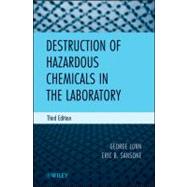
What is included with this book?
George Lunn, PhD, has been working as a review chemist for the FDA's Office of New Drug Quality Assessment since 1996. Previously, he was a senior research scientist in the Environmental Control and Research Program at the NCI-Frederick Cancer Research and Development Center. He has written nine books and over sixty papers and review articles.
Eric B. Sansone, PhD, was the director of the Environmental Control and Research Program at the NCI-Frederick Cancer Research and Development Center until his retirement. He has also worked as a consultant in industrial hygiene and air pollution control for a widely diversified group of industries, law firms, universities, and governmental agencies. He has published many articles on the assessment of risk in cancer research.
| Preface | p. xi |
| Acknowledgments | p. xiii |
| Introduction | p. 1 |
| Specific Methods for the Destruction of Hazardous Chemicals in the Laboratory | p. 17 |
| Acetonitrile | p. 19 |
| Acid Halides and Anhydrides | p. 23 |
| Anatoxins | p. 29 |
| Alkali and Alkaline Earth Metals | p. 37 |
| Alkali Metal Alkoxides | p. 41 |
| Anatoxin-A | p. 43 |
| Aromatic Amines | p. 47 |
| Arsenic | p. 57 |
| Azides | p. 61 |
| Azo and Azoxy Compounds and Tetrazenes | p. 69 |
| Boron Trifluoride and Inorganic Fluorides | p. 77 |
| Botulinum Toxins | p. 81 |
| Brevetoxins | p. 85 |
| Butyllithium | p. 89 |
| Calcium Carbide | p. 93 |
| Carbamic Acid Esters | p. 95 |
| Carbofuran | p. 99 |
| Chloromethylsilanes and Silicon Tetrachloride | p. 101 |
| N-Chlorosuccinimide and Chloramine-T | p. 103 |
| Chlorosulfonic Acid | p. 105 |
| Chromium(VI) | p. 107 |
| Citrinin | p. 113 |
| Complex Metal Hydrides | p. 121 |
| Cyanides and Cyanogen Bromide | p. 129 |
| Cylindrospermopsin | p. 137 |
| Diisopropyl Fluorophosphate | p. 141 |
| Dimethyl Sulfate and Related Compounds | p. 151 |
| Dyes and Biological Stains | p. 163 |
| Ethidium Bromide | p. 201 |
| Haloethers | p. 211 |
| Halogenated Compounds | p. 217 |
| Halogens | p. 229 |
| Heavy Metals | p. 233 |
| Hexamethylphosphoramide | p. 241 |
| Hydrazines | p. 245 |
| Hypochlorites | p. 257 |
| Mercury | p. 261 |
| 2-Methylaziridine | p. 267 |
| 1-Methyl-4-phenyl-1,2,3,6-tetrahydropyridine (MPTP) | p. 271 |
| Microcystins | p. 277 |
| 4-Nitrobiphenyl | p. 283 |
| 3-Nitrofluoranthene and 3-Aminofluoranthene | p. 287 |
| Nitrogen Tetroxide | p. 291 |
| N-Nitroso Compounds: Nitrosamides | p. 293 |
| N-Nitroso Compounds: Nitrosamines | p. 307 |
| Ochratoxin A | p. 319 |
| Organic Nitriles | p. 327 |
| Osmium Tetroxide | p. 331 |
| Palytoxin | p. 335 |
| Patulin | p. 339 |
| Peracids | p. 347 |
| Perchlorates | p. 349 |
| Peroxides and Hydroperoxides | p. 355 |
| Phenol | p. 359 |
| Phosgene | p. 363 |
| Phosphorus and Phosphorus Pentoxide | p. 367 |
| Picric Acid | p. 371 |
| Polycyclic Aromatic Hydrocarbons | p. 375 |
| Polycyclic Heterocyclic Hydrocarbons | p. 387 |
| Potassium Permanganate | p. 405 |
| ß-Propiolactone | p. 407 |
| Protease Inhibitors | p. 411 |
| Ricin | p. 417 |
| Saxitoxin | p. 421 |
| Selenium Compounds | p. 425 |
| Sodium Amide | p. 427 |
| Sterigmatocystin | p. 429 |
| Sulfonyl Fluoride Enzyme Inhibitors | p. 437 |
| Sulmr-Containing Compounds | p. 443 |
| T-2 Toxin | p. 449 |
| Tetrodotoxin | p. 455 |
| Triacetone Triperoxide | p. 459 |
| Uranyl Compounds | p. 463 |
| Methods for the Destruction of Pharmaceuticals in the Laboratory | p. 467 |
| Pharmaceuticals: General Considerations | p. 469 |
| Potassium Permanganate | p. 549 |
| Sodium Hypochlorite | p. 567 |
| Nickel-Aluminum Alloy Reduction | p. 575 |
| Fenton's Reagent | p. 583 |
| Photo-Fenton Reaction | p. 587 |
| Hydrogen Peroxide | p. 591 |
| Hydrogen Peroxide and Horseradish Peroxidase | p. 593 |
| Ozone | p. 595 |
| Hydroxylamine Degradation of ß-Lactams | p. "603 |
| Miscellaneous Chemical Degradation Procedures | p. 605 |
| Photolytic Degradation Procedures | p. 613 |
| Decontamination of Aqueous Solutions | p. 627 |
| Nonspecdtic Methods for the Destruction of Hazardous Chemicals in the Laboratory | p. 631 |
| Appendixes | p. 655 |
| Procedures for Drying Organic Solvents | p. 657 |
| Safety Considerations with Potassium Permanganate | p. 661 |
| Molecular Formula Index | p. 671 |
| Cas Registry Number Index | p. 681 |
| Cross Index of Pharmaceutical Names | p. 693 |
| Cross-Index of Names for Dyes and Biological Stains | p. 729 |
| Name Index | p. 757 |
| Table of Contents provided by Ingram. All Rights Reserved. |
The New copy of this book will include any supplemental materials advertised. Please check the title of the book to determine if it should include any access cards, study guides, lab manuals, CDs, etc.
The Used, Rental and eBook copies of this book are not guaranteed to include any supplemental materials. Typically, only the book itself is included. This is true even if the title states it includes any access cards, study guides, lab manuals, CDs, etc.